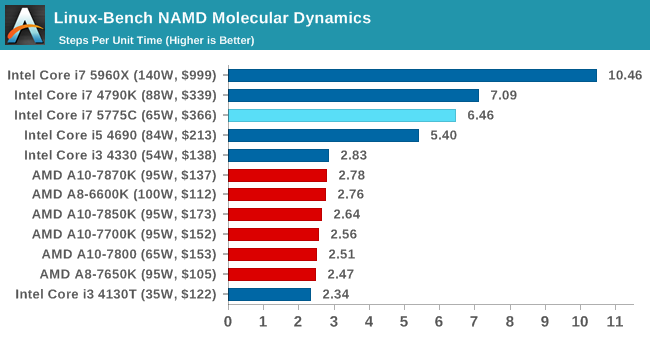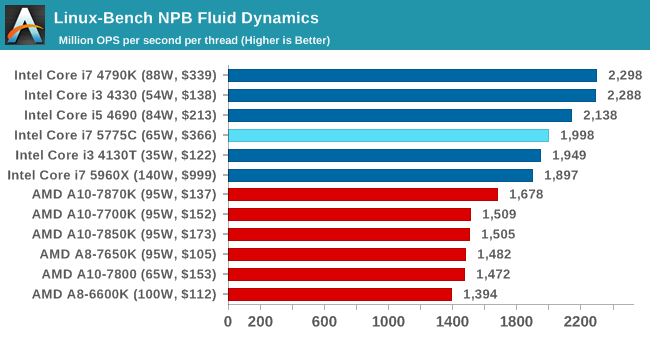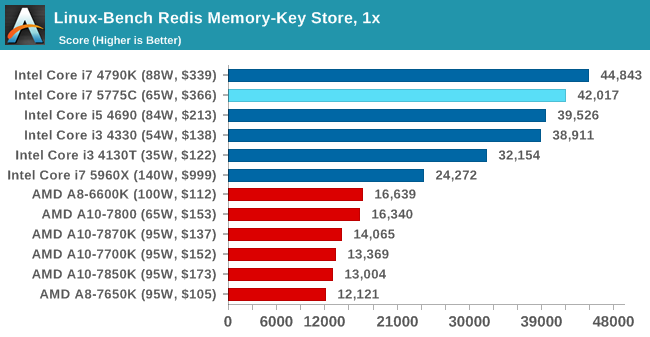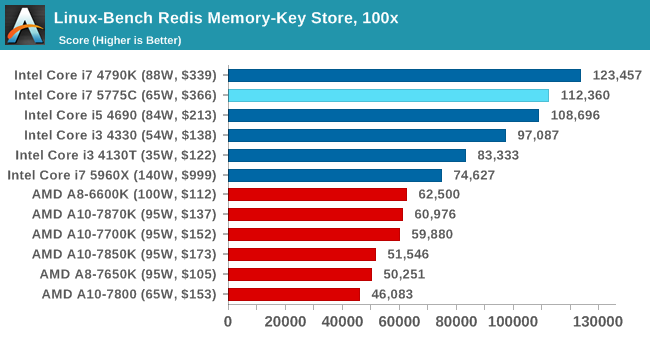The Intel Broadwell Desktop Review: Core i7-5775C and Core i5-5675C Tested (Part 1)
by Ian Cutress on June 2, 2015 7:45 AM ESTProfessional Performance: Linux
Built around several freely available benchmarks for Linux, Linux-Bench is a project spearheaded by Patrick at ServeTheHome to streamline about a dozen of these tests in a single neat package run via a set of three commands using an Ubuntu 11.04 LiveCD. These tests include fluid dynamics used by NASA, ray-tracing, OpenSSL, molecular modeling, and a scalable data structure server for web deployments. We run Linux-Bench and have chosen to report a select few of the tests that rely on CPU and DRAM speed.
Due to our limited testing time and other issues, only the i7-5775C was processed in our Linux tests. These should be updated for Part 2.
C-Ray: link
C-Ray is a simple ray-tracing program that focuses almost exclusively on processor performance rather than DRAM access. The test in Linux-Bench renders a heavy complex scene offering a large scalable scenario.

NAMD, Scalable Molecular Dynamics: link
Developed by the Theoretical and Computational Biophysics Group at the University of Illinois at Urbana-Champaign, NAMD is a set of parallel molecular dynamics codes for extreme parallelization up to and beyond 200,000 cores. The reference paper detailing NAMD has over 4000 citations, and our testing runs a small simulation where the calculation steps per unit time is the output vector.

NPB, Fluid Dynamics: link
Aside from LINPACK, there are many other ways to benchmark supercomputers in terms of how effective they are for various types of mathematical processes. The NAS Parallel Benchmarks (NPB) are a set of small programs originally designed for NASA to test their supercomputers in terms of fluid dynamics simulations, useful for airflow reactions and design.

Redis: link
Many of the online applications rely on key-value caches and data structure servers to operate. Redis is an open-source, scalable web technology with a b developer base, but also relies heavily on memory bandwidth as well as CPU performance.













196 Comments
View All Comments
nandnandnand - Tuesday, June 2, 2015 - link
A10-7870K is listed as $137 and A10-7850K as $173Ian Cutress - Tuesday, June 2, 2015 - link
$137 is the launch price of the A10-7870K.$173 was the launch price of the A10-7850K.
We mentioned why we do launch pricing in our graphs in previous reviews, but it comes down to our graphs not being dynamically linked to a retailer and we have to pick a point that's suitable over time. Launch pricing does that, even though there might be future discounts over time.
nandnandnand - Tuesday, June 2, 2015 - link
Ok, that makes sense.Business opportunity: add a drop down to switch from launch price to "live price" for Newegg/Amazon/etc., hyperlink live prices, get a cut from every click.
AS118 - Saturday, June 6, 2015 - link
I agree with nand. Other sites do this, and it's helpful to me because I often read reviews to make a purchase anyway, and it helps me see what the price is right now.FlushedBubblyJock - Sunday, June 14, 2015 - link
Take a look at how much the GTX980 stomps the amd 290X above - in the review here where they aren't concerned and paying attention and picking the best games for amd gimpy hardware.Just look at the FPS difference... let it sin in - the reviewers haphazardly reveal the truth when they are not intending to.
bloodroses75 - Wednesday, June 17, 2015 - link
Oh look, a current gen video card beat a last gen card that is just over half the price.You may want to try waiting until the 300 series is released/ bench marked before spouting how superior one is over the other. If the 300 series ends up being a dud (which it kinda looks like it will), so be it; at least it will be an 'apple to apple' comparison.
MrSpadge - Tuesday, June 2, 2015 - link
You don't need dynamically updated prices. simply pick the prices around the release date of the new hardware. If the price of a 1 or 2 years old comparison chip was lowered significantly (yes, this still happens sometimes), comparing it based on launch price is misleading and will always make some people shout "unfair". You easily fix this.taltamir - Tuesday, June 9, 2015 - link
I agree, the obvious thing to do is use the price as it is during the time the article was written.That means launch price for the item being reviewed and current prices for all items it is being compared to
ImSpartacus - Tuesday, June 2, 2015 - link
Since you have to do a "snapshot" pricing for these reviews, you may want to consider looking at average pricing at the time of review. At least then the time frame for each snap shot is the same.nathanddrews - Tuesday, June 2, 2015 - link
There's a fine line between "just enough" information and "too much". Prices for CPUs vary greatly depending on where you buy them.